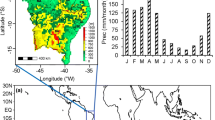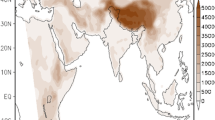Abstract
In the present study, simulations have been carried out to study the relationship between winter-time precipitations and the large-scale global forcing (ENSO) using the tropical band version of Regional Climate Model (RegT-Band) for 5 El Niño and 4 La Niña years. The RegT-Band model is integrated with the observed sea-surface temperature and lateral boundary conditions from National Center for Environmental Prediction (NCEP)-Department of Energy (DOE) reanalysis 2 (NCEP-DOE2). The model domain extends from 50°S to 50°N and covers the entire tropics at a grid spacing of 45 km, i.e., it includes lateral boundary forcing only at the southern and northern boundaries. The performance evaluation of the model in capturing the large-scale fields followed by ENSO response with winter-time precipitation has been carried out by using model simulations against NCEP-DOE2 and Global Precipitation Climatology Project (GPCP) precipitation data. The analysis suggests that the model is able to reproduce the upper airfields and large-scale precipitation during winter time, although the model has some systematic biases compared to the observations. A comparison of model-simulated precipitation with observed precipitation at 17 station locations has been carried out. It is noticed that the RegT-Band model simulations are able to bring out the observed features reasonably well. Therefore, this preliminary study indicates that the tropical band version of the regional climate model can be effectively used for the better understanding of the large-scale global forcing.


















Similar content being viewed by others
References
Adler, R.F., G.J. Huffman, A. Chang, R. Ferraro, P. Xie, J. Janowiak, B. Rudolf, U. Schneider, S. Curtis, D. Bolvin, A. Gruber, J. Susskind, and P. Arkin, 2003: The version 2 global precipitation climatology project (GPCP) monthly precipitation analysis (1979–Present). J Hydrometeorol, 4, 1147–1167.
Agnihotri, C.L., and M.S. Singh, 1982: Satellite study of western disturbances. Mausam. 33(2), 249–254.
Coppola E., F. Giorgi, L. Mariotti, and X. Bi, 2012: RegT-Band: A tropical band version of RegCM4. Clim. Res., 52, 115–133.
Dee DP., S.M. Uppala, A.J. Simmons, P. Berrisford, P. Poli, S. Kobayashi, U. Andrae, M.A. Balmaseda, G. Balsamo, P. Bauer, P. Bechtold, A.C.M. Beljaars, L. van de Berg, J. Bidlot, N. Bormann, C. Delsol, R. Dragani, M. Fuentes, A.J. Geer, L. Haimberger, S.B. Healy, H. Hersbach, E.V. Hólm, L. Isaksen, P. Kållberg, M. Köhler, M. Matricardi, A.P. McNally, B.M. Monge-Sanz, J.J. Morcrette, B.K. Park, C. Peubey, P. de Rosnay, C. Tavolato, J.N. Thépaut, and F. Vitart, 2011: The ERA-Interim reanalysis: configuration and performance of the data assimilation system. Q.J.R. Meteorol. Soc., 137, 553–597.
Dimri, A.P., 2013: Relationship between ENSO phases with Northwest India winter precipitation. Int. J. Climatol., 33, 1917–1923.
Dutta, R.K., and M.G. Gupta, 1967: Synoptic study of the formation and movement of western depressions. Indian J. Meteorol. Geophys., 18, 45–50.
Fritsch, J.M., and C.F. Chappell, 1980: Numerical prediction of convectively driven mesoscale pressure systems, part 1: Convective parameterization. J. Atmos. Sci., 37, 1722–1733.
Grell, G.A., 1993: Prognostic evaluation of assumptions used by cumulus parameterization. Mon. Wea. Rev., 121, 764–787.
Grell, G.A., J. Dudhia, and D.R. Stauffer, 1994: Description of the fifth generation Penn State/NCAR Mesoscale Model (MM5). Tech Rep TN-398 + STR, NCAR, Boulder Colorado, pp. 1–121.
Giannini, A., R. Saravanan, P. Chang, 2003: Oceanic forcing of Sahel rainfall on an interannual to interdecadal time scale. Science. 302, 1027–1030.
Giorgi, F., and G.T. Bates, 1989: The climatological skill of a regional model over complex terrain. Mon. Wea. Rev., 117, 2325–2347.
Harris, I., P.D. Jones, T.J. Osborn, and D.H. Lister, 2014: Updated high-resolution grids of monthly climatic observations—the CRU TS3.10 Dataset. Int. J. Climatol., 34, 623–642.
Holtslag, A., E. DeBruijn, and H.L. Pan, 1990: A high-resolution air mass transformation model for short-range weather forecasting. Mon. Wea. Rev., 118, 1561–1575.
Huffman, G.J., D.T. Bolvin, E.J. Nelkin, D.B. Wolff, and others, 2007: The TRMM multisatellite precipitation analysis (TMPA): quasi-global, multiyear, combined-sensor precipitation estimates at fine scale. J. Hydrometeorol. 8, 38–55.
Ihara, C., Y. Kushnir, M.A. Cane, and V.H. De La Pen˜a, 2007: Indian summer monsoon rainfall and its link with ENSO and Indian Ocean climate indices. Int. J. Climatol, 27, 179–187.
Ju, J., and J.M. Slingo, 1995: The Asian summer monsoon and ENSO. Q. J. R. Meteorol. Soc, 121, 1133–1168.
Kanamitsu, M., W. Ebisuzaki, J. Woollen, S.Y. Yang, J.J. Hnilo, M. Fiorino, and G.L. Potter, 2002: NCEP-DEO AMIP-II Reanalysis (R-2). Bull. Am. Met. Soc., 83, 1631–1643.
Kar, S.C., and S. Rana, 2014: Interannual variability of winter precipitation over northwest India and adjoining region: impact of global forcing’s. Theor. Appl. Climatol, DOI 10.1007/s00704-013-0968-z.
Kiehl, J.T., J.J. Hack, G.B. Bonan, B.A. Boville, B.P. Briegleb, D.L. Williamson, and P.J. Rasch, 1996: Description of the NCAR Community Climate Model (CCM3). NCAR Tech. Note NCAR/TN- 420 + STR, 152 pp.
Kripalani, R.H., and A. Kulkarni, 1997: Climatic impact of El Nino/La Nina on the Indian monsoon: a new perspective. Weather. 52, 39–46.
Krishna Kumar, K, B. Rajagopalan, and A. Cane, 1999: On the weakening relationship between the Indian monsoon and ENSO. Science. 284, 2156–2159.
Kummerow C., Y. Hong, W.S. Olson, S. Yang, and others, 2001: The evolution of the Goddard profiling algorithm (GPROF) for rainfall estimation from passive microwave sensors. J Appl. Meteorol. 40, 1801–1840.
Mariotti, A., 2007: How ENSO impacts precipitation over southwest central Asia? Geophys. Res. Lett, 34, L16706.
Mariotti, L., E. Coppola, M.B. Sylla, F. Giorgi, and C. Piani, 2011: Regional climate model simulation of projected 21st century climate change over an all-Africa domain: com- parison analysis of nested and driving model results. J. Geophys. Res, 116, D15111. doi:10.1029/2010JD015068.
Mitchell, T.D., and P.D. Jones, 2005: An improved method of constructing a database of monthly climate observations and associated high-resolution grids. Int. J. Climatol., 25, 693–712.
Mohanty, U.C., O.P. Madan, P.V.S. Raju, R. Bhatla, and P.L.S. Rao, 1999: A study on certain dynamic and thermodynamic aspects associated with Western Disturbances over north-west Himalaya. The Himalayan Environment (Eds. S.K. Dash and J. Bhadur), New Age International Pvt. Ltd., 113–122.
Mooley, D.A., 1957: The role of western disturbances in the production of weather over India during different seasons. Indian J. Meteorol. Geophys, 8, 253–260.
Murthi, A., K.P. Bowman, and L.R. Leung, 2011: Simulations of precipitation using NRCM and comparisons with satellite observations and CAM: annual cycle. Clim. Dyn, 36, 1659–1679.
Oleson, K. W., and coauthors, 2008: Improvements to the Community Land Model and their impact on the hydrological cycle. J. Geophys. Res., 113, G01021, doi:10.1029/2007JG000563.
Pal, J.S., F. Giorgi, X. Bi, N. Elguindi, F. Solmon, X. Gao, S.A. Rauscher, R. Francisco, A. Zakey, J. Winter, M. Ashfaq, F. Syed, S. Faisal, J.L. Bell, N.S. Diffenbaugh, J. Karmacharaya, A. Konare, D. Martinez, R.P. Da Rocha, L.C. Sloan, and A.L. Steiner, 2007: Regional climate modeling for the developing world: The ICTP RegCM3 and RegCNET. Bull. Amer. Meteor. Soc, 88, 1395–1409.
Pillai, P.A., 2008: Studies on the role of tropospheric biennial oscillation in the interannual variability of Indian summer monsoon. Ph.D dissertation, Cochin University of Science and Technology, 167 pp.
Pisharoty, P., and B.N. Desai, 1956: Western disturbances and Indian weather. Indian J. Meteorol. Geophys, 8, 333–338.
Rajeevan, M., J. Bhate, J. Kale, and B. Lal, 2006: High-resolution daily gridded rainfall data for the Indian region: analysis of break and active monsoon spells. Curr. Sci, 91, 296–306.
Rauscher, S.A., F. Kucharski, and D.B. Enfield, 2010: The role of regional SST warming variations in the drying of Meso-America in future climate projections. J. Clim, 24, 2003–2016.
Ray, P., C. Zhang, M.W. Moncrieff, J. Dudhia, J.M. Caron, L.R. Leung, and C. Bruyere, 2011: Role of the atmospheric mean state on the initiation of the Madden Julian oscillation in a tropical channel model. Clim. Dyn., 36, 161–184.
Reynolds, R.W., N.A. Rayner, T.M. Smith, D.C. Stokes, and W. Wang, 2002: An improved in situ and satellite SST analysis for climate. J. Climate., 15, 1609–1625.
Singh, M.S., and S. Kumar, 1977: Study of western disturbances. Indian J. Meteorol. Geophys, 28(2), 233–242.
Smith, T.M., R.W. Reynolds, C.P. Thomas, and J. Lawrimore, 2008: Improvements to NOAA’s Historical Merged Land-Ocean Surface Temperature Analysis (1880–2006). J. Climate, 21, 2283–2296.
Tanaka, H.L., N. Ishizaki, and A. Kitoh, 2004: Trend and inter-annual variability of Walker, monsoon and Hadley circula- tions defined by velocity potential in the upper troposphere. Tellus., 56 (A), 250–269.
Tawfik, A.B., and A.L. Steiner, 2011: The role of soil ice in land-atmosphere coupling over the United States: a soil moisture precipitation winter feedback mechanism. J Geophys Res 116, D02113. doi:10.1029/2010JD014333.
Tiwari, P.R., S.C. Kar, U.C. Mohanty, S. Dey, P. Sinha, P.V.S. Raju, and M.S. Shekhar, 2014: Dynamical downscaling approach for wintertime seasonal scale simulation over the Western Himalayas. Acta Geophys., 62 (4), 930–952.
Tulich, S.N., G.N. Kiladis, and A.S. Parker, 2010: Convectively-coupled Kelvin and easterly waves in a regional climate simulation of the tropics. Clim. Dyn., 36, 185–203.
Yadav, R.K., K. Rupa Kumar, and M. Rajeevan, 2009: Increasing influence of ENSO and decreasing influence of AO/NAO in the recent decades over northwest India winter precipitation. J. of Geophys.Res., 114, D12112, doi:10.1029/2008JD011318, 1–12.
Yadav, R.K., J.H. Yoo, F. Kucharski, and M.A. Abid, 2010: Why Is ENSO Influencing Northwest India Winter Precipitation in Recent Decades? J. Climate., 23, 1979–1993.
Acknowledgments
Snow and Avalanche Study Establishment (SASE) supported this study. The RegCM4.1.1 installed at IIT Delhi was developed at the Abdus Salam ICTP, Trieste, Italy. Partial financial grant from Department of Science and Technology, Govt. of India (DST/CCP/PR/11/2011) through a research project operational at IIT Delhi (IITD/IRD/RP2580) is acknowledged. The authors acknowledge the National Center for Environmental Prediction (NCEP), Global Precipitation Climatology Project (GPCP) USA, and India Meteorological Department for providing valuable data sets for accomplishing this work. The authors are thankful to Bianca C. for editing/correcting the English of the manuscript.
Author information
Authors and Affiliations
Corresponding author
Rights and permissions
About this article
Cite this article
Tiwari, P.R., Kar, S.C., Mohanty, U.C. et al. Simulations of Tropical Circulation and Winter Precipitation Over North India: an Application of a Tropical Band Version of Regional Climate Model (RegT-Band). Pure Appl. Geophys. 173, 657–674 (2016). https://doi.org/10.1007/s00024-015-1102-1
Received:
Revised:
Accepted:
Published:
Issue Date:
DOI: https://doi.org/10.1007/s00024-015-1102-1




